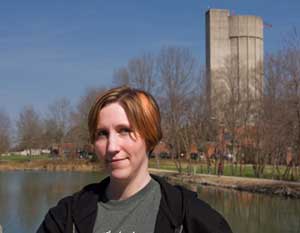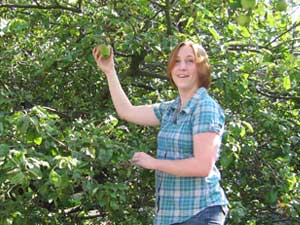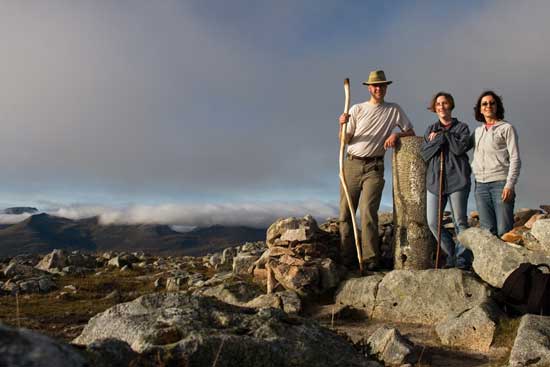Kelly Chipps

Kelly at ORNL, with the tandem in the background
![]()
Kelly (with Geiger counter) being interviewed by an Albuquerque news agency during one of the open days at the Trinity Site

Kelly Picking apples from Newton's Apple Tree in the courtyard of the Physics building in York, UK
What if only a few people could understand you? What if your phrases were littered with words like subatomic, gravitational assist, or H-theorem? It would probably be difficult to get your point across, let alone order a cheeseburger. Nuclear physicist Kelly Chipps (AKA Nuclear Kelly) understands just how difficult it is for some people to understand physicists, and with her diverse background she is striving to make physics accessible to everyone.
Being capable of communicating “is important in order to convey the information across the barrier,” says Chipps. Chipps, whose father was a chemical engineer and mother was an elementary school teacher, is a talented writer and nuclear physicist breaking barriers and stereotypes of what it means to talk like a physicist. Chipps not only works for the Colorado School of Mines as a postdoctoral fellow, she also is an accomplished musician, a published writer and a blogger.
Her research is out -of-this-world. She searches for ways to measure the reactions that take place in stars. “When you can sufficiently know what is happening inside stars and supernova, you can figure out what’s in us. We measure those reactions to be able to understand how much of any given thing is in the universe and that should tell us how much is in us,” said Chipps. But, why is that important? “It is important because we are all stardust. It’s true; everything on Earth is made from the elements that are generated in the scenarios in astrophysics,” she said. She also recognizes that her research has more direct implications to nuclear energy and nuclear medicine. Chipps currently spends a lot of time at the Oak Ridge National Laboratory (ORNL) in Tennessee where she works in a facility that creates radioactive nuclei and sends them through the world’s largest tandem accelerator, resembling a six-story-high Van de Graaf generator, the giant metal ball that uses static electricity to make people’s hair stand on end in science museums and physics classrooms. In her research, the beams of radioactive nuclei are sent through the tandem accelerator and “then we can smash them into targets and measure what comes out the other side. This helps us understand what makes up these particles and how they interact,” said Chipps.
Although the tandem accelerator is inside a gigantic chamber of inert gas, it will sometimes spark, sounding like intense thunder, which takes many of the scientists by surprise and inevitably causes people to shudder.
Chipps wasn’t always smashing nuclei and playing with large-scale, mad-scientist-like equipment. She describes herself as a normal child, playing on the swing set, digging in the dirt, catching frogs and eating “bad” food like pizza rolls, but Chipps also really enjoyed school and learning about new things. When she was in high school she wanted to be a zoologist. She said, “I wanted to go out into the middle of the woods and study wolves.” She was so intent on taking this path that she rearranged her schedule so that she could take biology her senior year and be better prepared for her upcoming college classes. So, her junior year she took physics. Her physics teacher, Stefan Kern, was from Germany and she remembers him as being “so interested in what he was doing. You could tell he loved physics and I wanted to know why that was.” She decided to drop biology from her senior schedule and instead take the advanced physics class taught by Mr. Kern. Through her studies she discovered why she liked physics. She said, “Here’s something on a fundamental level that explains why things are.” A concept she continues to explore in her research.
In high school Chipps was also a member of the band, but she hasn’t outgrown her affection for music. “I was in band all my life and I’ve played with several orchestras,” she said. She would love to continue to play in orchestras, but mostly she plays for personal enjoyment, since moving around from place to place as a postdoc makes establishing herself in a local orchestra difficult. Chipps also recognizes a connection between music and physics. “At a fundamental level they stem from the same thing in that they are both very mathematical,” she said. However, the mathematical connection does not hinder her ability to be creative.
“As much as I enjoy science and figuring out the fundamental technical questions, at the same time I have to have a creative outlet,” she said. Besides music, Chipps uses writing as a creative channel. “I’m a published author outside of science,” she said. Chipps has written and published short stories and poetry as well as a nonfiction book exploring the clash between science and religion. Chipps also keeps a blog, Miss Atomic Bomb: The life and times of a female researcher in nuclear physics, where she explores what it means to be a physicist, how science is important in society, and continues to advocate for scientific funding and research and communication. Chipps is also a regular contributor on PhysicsCentral’s Ask-A-Physicist.

Kelly (center) with fiancé Steve (left) and friend Baharak (right) hiking in the Scottish Highlands
Read some of Chipps' contributions to Ask-A-Physicist:
If a helicopter hovers in a fixed position for 24 hours will the earth rotate around it?
Are airport whole body x-ray scanners safe for frequent travelers?














